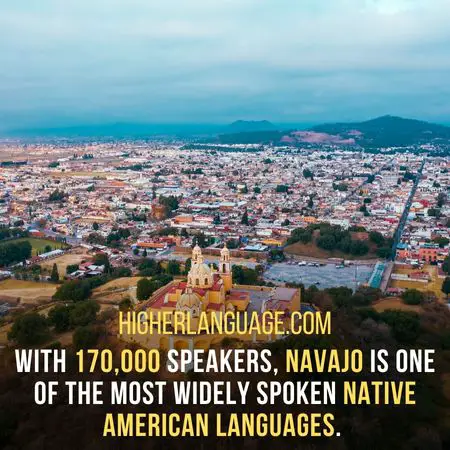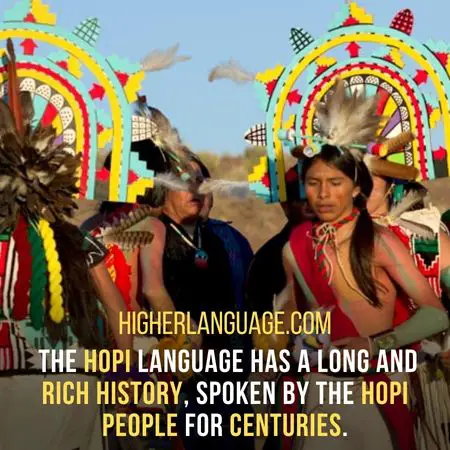Navajo is a tonal language spoken by the people of Arizona and New Mexico. Like most languages in the world, there are also languages similar to Navajo.
[toc]
The Navajo language has various dialects and languages similar to it. Let us explore them in detail.
5 Languages Similar To Navajo
The Navajo language is a Southern Athabaskan language spoken by the Diné (Navajo) people of the southwestern United States.

The Language is one of the most widely spoken Native American languages, with about 170,000 speakers in Arizona, New Mexico, and Utah.
Navajo is an unwritten language with many dialects related to other Athabaskan languages, such as Apache and Gwich’in.
Several related languages to Navajo form the Southern Athabaskan Languages subgroup.
Navajo has influenced other Languages as well. For example, it has been used to develop a pidgin language called Diné bizaad Bígóona’ígíí.
It is used by people who speak multiple languages to communicate with each other.
Navajo has also been used as a base language for creating computer programs and digital media.
The languages similar to Navajo are all closely related, yet they still differ in their unique way.
That makes learning these languages fascinating and rewarding for those who are interested.
Here are the top five languages similar to Navajo!
1. Yaqui:
Yaqui is a Uto-Aztecan Language spoken by 18,000 people in the Mexican state of Sonora.
Yaqui is a Native American language spoken by the Yaqui people. It is part of the Uto-Aztecan language family and is related to Navajo in many ways.
The Yaqui Language has its unique alphabet, vocabulary, and cultural conventions, which differ from other languages.
However, it has many similarities to Navajo, as it shares some key language features. Examples include the use of tones, noun classes, and possessive pronouns.
Let us look at the similarities and differences in detail.
Similarities:
Both languages use tones to differentiate between words. For example, in Yaqui, the words “rain” and “not rain” are distinguished by a rising and falling tone.
Both languages also use noun classes to help distinguish between types of nouns.
For example, in Yaqui, animate (living) nouns are grouped, while inanimate (non-living) nouns are grouped.
Finally, both languages use possessive pronouns to indicate ownership. These pronouns help to form meaningful sentences in Yaqui and Navajo.
The languages also share some vocabulary and phonology similarities.
For example, both languages use a series of glottal stops and have similar words for common concepts like “water” and “mountain.”
Differences:
While Yaqui and Navajo have many similarities, they also have some differences.
For example, while both languages use verb conjugation to indicate the person acting, Navajo has more complex verb forms than Yaqui.
Additionally, Yaqui tends to focus on using direct objects in a sentence, while Navajo focuses more on indirect objects.
Finally, Yaqui is written in Latin, while Navajo is still spoken and not widely written.
2. Chiricahua Apache:
Chiricahua Apache is a Southern Athabaskan language spoken in Mexico and the United States.

The Chiricahua Apache language is one of the members of the Athapaskan language, which has been present in North America for several thousand years.
During this time, it was spoken in a large area that included parts of Arizona and New Mexico.
However, with the arrival of Europeans to the area, the language began to decline. Hence many speakers relocated to Oklahoma in the late 1800s.
By the mid-20th century, only a handful of Chiricahua Apache speakers were left, and many of them had begun switching to other languages like English and Spanish.
Today, efforts are being made to revitalize the language by helping young people learn it, allowing it to be passed down through generations.
Similarities:
Both languages use a system of verb conjugation to indicate past, present, and future tenses. For example, they both use prefixes and suffixes to denote tense.
Additionally, both languages have a complex system of honorifics that are used to differentiate between people in terms of age and social status.
The two languages also share many words and phrases, including similar ones.
For example, Chiricahua Apache’s “Ishtáádééh” is similar to Navajo’s “Yahtáadí“, which both mean “welcome.”
The word order in both languages is subject–object–verb (SOV).
Both languages have a complex system of noun classifiers that grammatically classify nouns.
For example, in Navajo, noun classifiers help differentiate between humans and animals or animate and inanimate objects.
They also share many words about plants, animals, and other natural elements.
All in all, the similarities between Chiricahua Apache and Navajo are remarkable.
They share many of the same linguistic features that distinguish them from other Native American languages.
Differences:
The main difference between Chiricahua Apache and Navajo is in their grammar.
While both languages are considered head-marking, where the speaker indicates the grammatical role of another party through affixes.
Navajo follows a more typologically conservative pattern than Chiricahua Apache.
In addition, Chiricahua Apache and Navajo have different verb systems, with the former using lexical verbs in place of some aspectual morpheme choices.
That differs from other language families, where one verb form might get used to express multiple ideas.
Finally, pronunciation can vary between the two languages as well.
For example, while both use similar sound inventories, Chiricahua Apache tends to have more complex syllable structures than Navajo.
In conclusion, while there are similarities and differences between Navajo and Chiricahua Apache, they remain two distinct languages with unique characteristics.
3. Hopi:
Hopi is a Uto-Aztecan language spoken by the Hopi people of Arizona. About 8,000 people speak it.
The language has three dialects, Upper Moencopi, Lower Moencopi, and Sipaulovi.
It is notable for its complex grammar which includes differences between direct and indirect speech.

The Hopi language has a long and rich history, having been spoken by the Hopi people for centuries.
It is closely related to other Uto-Aztecan languages, such as Chiricahua Apache and Navajo.
The first written record of the Hopi language dates back to 1628 when Father Eusebio Kino encountered the Hopi people and learned their Language.
Since then, the language has been recorded in various writings and publications, helping to preserve its history.
It is closely related to languages in the same family, such as Navajo and Chiricahua Apache.
However, it shares some traits with these languages, such as similar sound inventories and grammatical structures.
Similarities:
Both languages use an ergative-absolutive case system. For example, Hopi makes an ergative-absolutive distinction with verbs, while Navajo marks nouns.
Both languages also use vowel harmony in some areas of their grammatical systems.
That means that when certain vowels are used together in a word, they must follow specific patterns and rules.
Finally, both languages have similar phonemic inventories. That means they share some of the same sounds, such as /th/, /l/, and /r/.
Finally, both languages feature several prefixes and suffixes to indicate grammatical functions.
Differences:
Despite these similarities, there are still considerable differences between Hopi and Navajo. The most obvious is their lexicon or vocabulary.
Each language has its unique set of words that have been developed over time, making them distinct.
Additionally, Hopi has many more grammatical rules and forms than Navajo does.
Another difference is that while Navajo has many loan words from Spanish, Hopi does not. For example, the Hopi word for “man” is “kíya“, whereas, in Navajo, it is “tábąąh.”
In addition, the sounds in both Hopi and Navajo are similar, though there are some notable differences.
For example, Hopi does not contain the “ts” sound in Navajo words.
However, despite the differences between the two languages, they remain part of the same language family.
4. Keresan:
Keresan is spoken by the Keres Puebloans, who are indigenous peoples in New Mexico.
It is a language of the Keresan branch of the Uto-Aztecan language family and is closely related to Navajo and Apache.
Languages within this group share many common vocabulary items and grammatical structures, making them similar enough for speakers of one to understand easily.

Keresan has several dialects that differ slightly in terms of pronunciation and vocabulary.
The most widely used dialect is Western Keresan which is spoken in Acoma, Santa Ana, and Laguna Pueblos.
Other dialects include Eastern Keresan, spoken in the Pueblos of Cochiti, San Felipe, Santo Domingo, Zia, and Jemez.
Lastly, Southeastern Keresan, spoken in the Pueblos of Isleta and Sandia, and Southwestern Keresan, which the Zuni people speak.
All dialects are mutually intelligible and have a high degree of similarity with Navajo.
Similarities:
Both languages are based on word order, meaning the order of words in a sentence is important.
For example, in Navajo, you would say “Nihi Dine’é baa aghaani” (I am a Diné person).
In contrast, in Keresan, you would say, “Diné baa níhi aghaani” (I am a Diné person).
Both languages also have similar pronouns and possessive adjectives.
They also have similar grammatical structures, such as verb conjugations and noun declensions.
For example, in Navajo, you would say “Ahéhee‘ (thank you), whereas, in Keresan, you would say “Ahéhe‘”.
Navajo and Keresan use verbal systems to express tense, mood, person, and other elements of meaning.
Such as, the Navajo “hoghan” is a verbal inflection system that conveys tense, mood, and other elements of meaning in one word.
Differences:
There are also some significant differences between these languages.
While most words in Navajo and Keresan have similar sounds, the vocabularies can be quite different.
Additionally, Navajo has several dialects, which are distinct in their pronunciation and lexicon.
Another difference is that Navajo is an agglutinative language, whereas Keresan is a polysynthetic language.
Navajo expresses complex ideas by combining several words or morphemes, while Keresan usually uses one long, compound word.
Finally, the noun and verb inflection systems of both languages are quite different from each other.
For example, Navajo nouns are inflected for number, classifiers, and possession, while Keresan nouns are inflected for case and gender.
Additionally, the verb systems of both languages differ greatly in their structure though they share some common features such as switch reference and mood constructions.
Despite their many similarities, there are also several significant differences between the two languages.
Navajo and Keresan are important languages in the Southwest, but they provide very different linguistic experiences for their speakers.
5. Gwich’in:
Gwich’in is another language related to Navajo and Keresan, but Indigenous peoples speak it in the northern part of North America.
It is a Northern Athabaskan language that shares some similarities with Navajo, such as its possessive pronouns and verb structure.

Approximately 9,000 people speak Gwich’in in Alaska, the Northwest Territories, and northern Canada.
It is the official Language of the Inuvialuit Settlement Region in Canada and is recognized by the Gwich’in Tribal Council.
Gwich’in has a long history, with written records of the language dating back to the late 1700s.
The Gwich’in language is part of a larger group of Athabaskan languages spoken in western Canada and Alaska.
The relationship between Navajo and Gwich’in is very close, but they are not mutually intelligible.
Similarities:
The grammar and structure of the Gwich’in language are very similar to that of Navajo.
For example, both languages have many noun classes, verb conjugations, and pronouns.
In addition, both languages use a verb-subject-object word order in their sentences.
Like Navajo, Gwich’in has a strong oral tradition. However, the language has uniquely evolved, and its vocabulary contains words not found in other Athabaskan languages.
Commonly used Gwich’in words include dahdah (hello), choo (thank you), and ghaa (goodbye).
Finally, both languages extensively use reduplication, repeating a word or syllable to create a new meaning.
Differences:
Although Gwich’in and Navajo share many similarities, there are key differences between the two languages.
For example, Gwich’in speakers use many prefixes and suffixes to modify nouns and verbs, while Navajo use these less extensively.
Additionally, Gwich’in has several distinct dialects, while Navajo is one Language with no dialectal variation.

Finally, Gwich’in has adopted many words from other languages, such as English, French, and Cree, while Navajo has retained its original vocabulary.
Although there are some important differences between the two language groups, they share more similarities than differences.
That makes them both viable options for those interested in learning a language similar to Navajo.
Final Thoughts:
Navajo is a complex language with many dialects and unique vocabulary.
Although there are other languages similar to Navajo, they sometimes capture different nuances of grammar and semantics.
Languages such as Gwich’in can be useful alternatives for those who want to learn something similar to Navajo.
Still, it’s important to remember that the two have important differences. It’s worth taking a closer look at both languages to determine which is best for you.
Languages similar to Navajo can be a great way to explore and understand the culture of the Diné people.